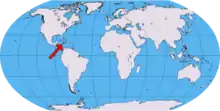Jamaican crow
The Jamaican crow (Corvus jamaicensis) is a comparatively small corvid (35–38 cm in length). It shares several key morphological features with two other West Indian species, the Cuban crow (Corvus nasicus) and the white-necked crow (Corvus leucognaphalus) of Hispaniola, which are very closely related to it.
| Jamaican crow | |
|---|---|
 | |
| Illustration by Philip Henry Gosse from 1849 | |
 | |
| In flight, near Cockpit Country, Jamaica | |
| Scientific classification | |
| Domain: | Eukaryota |
| Kingdom: | Animalia |
| Phylum: | Chordata |
| Clade: | Dinosauria |
| Class: | Aves |
| Order: | Passeriformes |
| Family: | Corvidae |
| Genus: | Corvus |
| Species: | C. jamaicensis |
| Binomial name | |
| Corvus jamaicensis Gmelin, JF, 1788 | |
 | |
| Distribution map | |
Taxonomy
The Jamaican crow, under the name "chattering crow", was described by the English naturalists John Ray in 1713 and Hans Sloane in 1725.[2][3] The Irish physician Patrick Browne used the name "gabbling crow" for the species in 1756.[4] In France the naturalists Mathurin Jacques Brisson in 1760 and Comte de Buffon both used the name "La corneille de la Jamaique".[5][6] A binomial name was not introduced until 1788 when the German naturalist Johann Friedrich Gmelin revised and expanded Carl Linnaeus's Systema Naturae and coined the binomial name Corvus jamaicensis.[7] The species is monotypic: no subspecies are recognised.[8]
Description
The overall appearance is sooty-grey, not at all glossy, like its relatives; though it does possess a similar dark grey patch of naked skin just behind the eye, and a smaller naked patch at the base of the bill. The bill itself is slate-grey and quite deep, tapering to a sharp point. The nasal bristles are relatively sparse usually leaving the nostrils on view. The iris is either grey-brown or red-brown, possibly depending on age. The legs and feet are black.
The voice, like its two nearest relatives, is very distinctive and consists of various jabbering and bubbling sounds (thus its common Jamaican Patois name, jabbering crow), but also a more leisurely “craaa-aa” and variations thereof, and somewhat of a musical burbling.[9]
Distribution and habitat
As its name suggests, this species is found on the island of Jamaica, where it inhabits woodland mixed with cleared areas, and can be frequently found in larger gardens. Though primarily a bird of hill and mountain forest, it comes down to lower elevations during the dry season, where it is more likely to be seen.
Behaviour and ecology
Food and feeding
A forest crow by nature, its food requirements contain a significant proportion of fruit taken from trees, either in pairs or small groups. It also probes under bark and leaf litter for small invertebrates and lizards, and it is known to raid other birds nests of both eggs and nestlings.
Breeding
The nest itself is usually built in tall trees; this species may also use tree holes as a possible nesting option, although not yet recorded for this species and its breeding habits.
References
- BirdLife International (2020). "Corvus jamaicensis". IUCN Red List of Threatened Species. 2020: e.T22706007A182093614. doi:10.2305/IUCN.UK.2020-3.RLTS.T22706007A182093614.en. Retrieved 19 November 2021.
- Ray, John (1713). Synopsis methodica avium & piscium (in Latin). London: William Innys. p. 181.
- Sloane, Hans (1725). A Voyage to the Islands Madera, Barbados, Nieves, S. Christophers and Jamaica : with the natural history of the herbs and trees, four-footed beasts, fishes, birds, insects, reptiles, &c. of the last of those islands. Vol. 2. London: Printed for the author. p. 298.
- Browne, Patrick (1756). The Civil and Natural History of Jamaica. London: Printed for the author, and sold by T. Osborne and J. Shipton. pp. 473–474.
- Brisson, Mathurin Jacques (1760). Ornithologie, ou, Méthode Contenant la Division des Oiseaux en Ordres, Sections, Genres, Especes & leurs Variétés (in French and Latin). Vol. 2. Paris: Jean-Baptiste Bauche. pp. 22–24. The two stars (**) at the start of the section indicates that Brisson based his description on the examination of a specimen.
- Buffon, Georges-Louis Leclerc de (1775). "La corneille de la Jamaique". Histoire Naturelle des Oiseaux (in French). Vol. 3. Paris: De l'Imprimerie Royale. pp. 67–68.
- Gmelin, Johann Friedrich (1788). Systema naturae per regna tria naturae : secundum classes, ordines, genera, species, cum characteribus, differentiis, synonymis, locis (in Latin). Vol. 1, Part 1 (13th ed.). Lipsiae [Leipzig]: Georg. Emanuel. Beer. p. 367.
- Gill, Frank; Donsker, David; Rasmussen, Pamela, eds. (January 2023). "Crows, mudnesters, birds-of-paradise". IOC World Bird List Version 13.1. International Ornithologists' Union. Retrieved 14 April 2023.
- "Jamaican Crow - eBird". ebird.org. Retrieved 2019-09-11.
